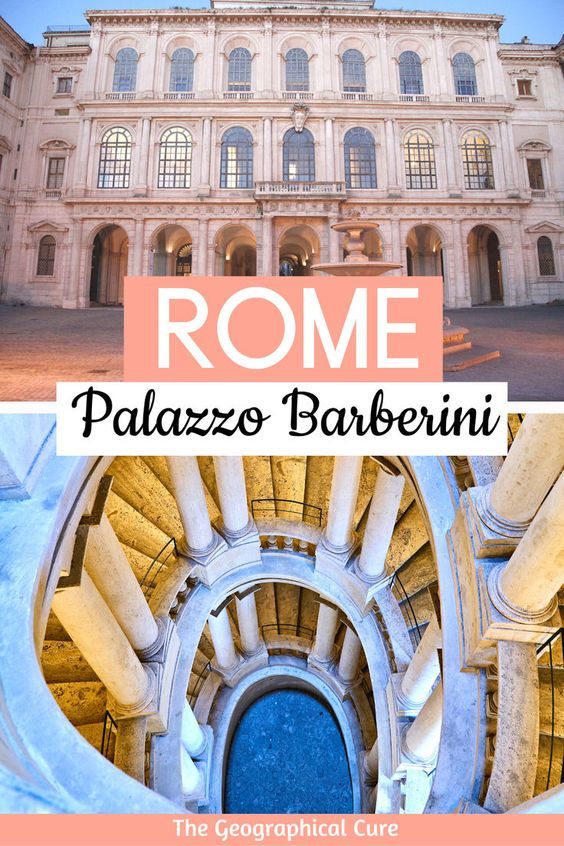Palazzo Barberini is an art lover’s art gallery. It holds some of Europe’s greatest masterpieces.
The museum is housed in a luxurious 17th century Baroque palace. It’s fully renovated and unapologetically grand. The palace is a magnificent backdrop for the Barberini’s stunning art collection. And you can see them without the usual crowds in Rome.
The collection does have a slightly off putting name. It’s officially known as the National Gallery of Ancient Art or, in Italian, the Galleria Nazionale d’Arte Antica.
Don’t let the arcane name dissuade you from visiting. Its best works are from the Renaissance and Baroque periods.
You can see masterpieces by Caravaggio, Guido Reni, Hans Holbein, Bronzino, Raphael, Tintoretto, and Bernini.
The artworks in this museum are spread across two floors in two different buildings. You start with the early Quattrocento masters in Rooms 1-11. After exploring these, you’ll step outside to move to the next building.
There, in Rooms 12-42, you’ll find art from the 16th to the 18th century. A beautiful marble staircase connects the ground floor to the piano nobile, the main floor of the house.
As you walk up the stairs, you’ll see classical sculptures from Cardinal Francesco’s impressive collection. These pieces have been specially restored by the family’s sculptor, Niccolò Menghini.
Who Were The Barberini?
The Family
In the early 11th century, the Barberini family settled in the Florence area. The first prominent member was Francesco di Antonio, who grew rich with a textile business. But he was always in conflict with another famous Italian dynasty, the Medici of Florence.
In the 16th century, the Medici were the most powerful family in Florence. They overthrew the Republic of Florence and seized power. Because the Barberini had helped defend the city, they were deemed the Medici’s enemy.
The Barberini clan fled to Rome. The Medici nonetheless murdered Francesco in cold blood on the streets of Rome.
But one of his sons, Francesco di Carlo, escaped their grip and prospered. He became a high ranking church official and the papal treasurer. With these titles, he grew the Barberini family’s wealth.
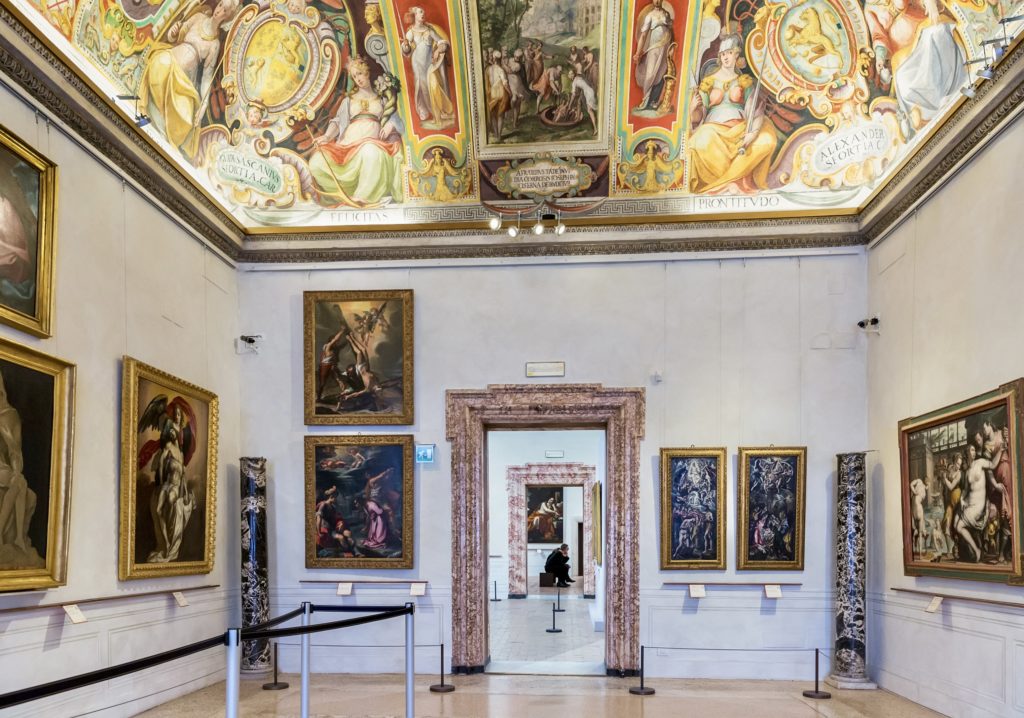
By the 17th century, the Barberini family were firmly ensconced in Rome’s upper echelons. Their most influential member was Cardinal Maffeo Barberini, who became Pope Urban VIII in 1623.
The Barberini family, like other powerful families, used symbols to express their power and noble position. Pope Urban grandiosely embraced bee iconography.
He changed the family coat of arms from a horsefly to three bees on a blue background, next to a papal tiara and the keys to St. Peter’s Basilica.
In that era, bees were a Christian symbol. They conveyed devotion, hard work, eloquence, and dedication.
Bee honey was a sweet symbol of the divine. Even pre-monotheism, Zeus was supposedly fed by bees. How’s that for a self important way to express your family’s power?
Gian Lorenzo Bernini, the famous Baroque sculptor, used bees to adorn many of his creations for the Barberini, including the Triton Fountain and the Fountain of Bees right in the Piazza Barberini.
As the association with the brilliant Bernini suggests, the Barberini were great patrons of Baroque art.
Pope Urban VIII hired Bernini to help rebuild St. Peter’s and create the baldacchino (high altar) for the church. The Barberini amassed a great art collection to decorate their palazzo.
But Pope Urban VIII was controversial and likely abused his position. He was known for his extreme nepotism. He made his relatives cardinals and gifted them large sums of money and land.
To create the baldacchino of St. Peter’s, Urban VIII removed bronze beams from the portico of the Pantheon. One critic said “What the barbarians did not do, the Barberini did.” When Urban VIII lost a major battle in 1643 to a rival, that was the end of the Barberini family.
The next pope was Innocent X from the Doria Pamphilj family. He launched an investigation of the Barberini, finding they’d amassed a fortune far exceeding that of the entire papal states.
The Barberini nephews fled, once more, to France. They eventually reconciled with the pope through marriage ties.
The Palace
In 1623, Pope Urban VIII hired renowned architect Carlo Maderno to design a villa fit for his family’s exalted status.
When Maderno died, the architects Borromini and Bernini took over the project. The elegant product is one of Rome’s most beautiful Baroque buildings.
The palazzo is in an H-shaped open plan with two parallel wings. It has a central septum (dividing partition) with an arcade entrance and false upper open gallery. This is where you’ll find the Bernini sculptures.
The palace was inhabited mainly by Pope Urban VIII’s two nephews Taddeo and Francesco Barberini. The Barberini Palace is 12,000 square meters and has 187 rooms. It has beautiful staircases by Borromini and Bernini.
The Barberini art collection housed there includes works from the likes of Raphael, Andrea del Sarto, Tintoretto, Bronzino, Titian, El Greco, Guido Reni, Domenichino, Caravaggio, Bernini, and Poussin.
There’s also a collection of ancient statues and reliefs. The Palazzo Barberini was eventually bought by the Italian state in 1949.
Between 2006 and 2010, the Palazzo Barberini underwent a major renovation.
In 2019, the museum re-opened 10 newly restored rooms in the north wing and opened another 10 new rooms in the south wing. The south wing addition included the private apartments of the Barberini cardinals.
Now, you can exit the museum via Borromini’s grand helicoidal staircase (shown above). The oval shaped staircase slowly spirals upward to a skylight. If you look closely, you can see bees decorating the columns.
You can also book a guided tour to see the 2nd century B.C. Mithraeum underneath the Palazzo Barberini, which was discovered in 1936.
Guide To The Palazzo Museum: What To See
Here are my top picks for the must see masterpieces at the Palazzo Barberini.
1. Raphael, La Fornarina
This painting is the crown jewel of the Palazzo Barberini. What makes La Fornarina so famous? The painting is beautiful, refined, and has a torrid backstory.
While Raphael was painting frescos at the Villa Farnesina, he began an affair with the subject of the painting — the baker’s daughter, Margherita Luti, called La Fornarina. She lived down the street in Trastevere.
Raphael’s infatuation with La Fornarina consumed him. He began to skip work to see her. Raphael’s patron, Agostino Chigi, grew frustrated. He even had La Fornarina kidnapped to prevent Raphael from seeing her.
READ: Guide To Raphael’s Paintings
But that stratagem didn’t succeed. A lovestruck Raphael grew depressed and still didn’t work. This all stalled Chigi’s grand project. Finally, Chigi gave up and had La Fornarina move in to keep a bewitched Raphael content.
In 1520, Raphael died abruptly at just 37. The diagnosis? According to fellow painter and historian Giorgio Vasari, Raphael died from “too much sex,” which caused him to spike a fever. His bedmate on his last happy night? Most likely, La Fornarina.
Unlike much of Raphael’s other work, this is an intimate portrait. La Fornarina’s right hand rests over her heart and her left hand between her legs.
It’s a Venus-like posture reminiscent of The Capitoline Venus in Rome’s Capitoline Museums, equating La Fornarina with the goddess of love.
She wears an armband inscribed with Raphael’s name, which seems proprietary. La Fornarina isn’t a remote idealized nude either, but a sensual lover. Her enigmatic face has been compared to Leonardo’s Mona Lisa.
At the time, a high born Raphael was engaged to a cardinal’s niece. They never married because Raphael procrastinated for 6 years. Some speculated that the ring on La Fornarina’s left hand might mean that Raphael was already secretly married to La Fornarina.
The ring was only discovered in 2001 during x-ray analysis. Experts think it might have been painted over by Raphael’s pupil to hide the affair and/or marriage.
It would’ve been a scandal at the time — superstar Raphael with a lowly girl from the working class. Four months after Raphael’s death, La Fornarina checked herself into a nunnery as a window.
2. Caravaggio, Narcissus at the Source
Narcissus is one of Caravaggio’s most beautiful paintings. It’s based on the Greek myth of Narcissus, most famously recorded by Roman poet Ovid.
The myth is a tragic story about a boy who falls in love with his reflection in inky waters. Narcissus is a preternaturally handsome and vain lad. He can’t find anyone to strike his fancy among the adoring female hordes.
One day, when he passes a pool of water, Narcissus is taken with his own image. So taken that he tries to kiss the image, falls in, and drowns.
Narcissus is transformed into a flower. Both the flower, the Narcissus, and the condition, narcissism, are named after this moment.
Caravaggio’s painting is a darkly melancholic morality tale. It’s an almost abstract depiction of a double figure, real boy and reflected boy.
The boy is dressed in 16th century attire. The surface of the water divides the canvas in half, with only a small strip of dirt to delineate the scene.
The painting has all the quintessential Baroque elements — emotion and longing on the boy’s face, a naked knee centering the composition, and stark lighting and shadow effects.
3. Caravaggio, Judith and Holofernes
Much like La Fornarina, this painting alone justifies a visit to the Palazzo Barberini. Judith Beheading Holofernes is one of Caravaggio’s most famous paintings. This painting shows a classic (and juicy) biblical scene, popular with many artists.
It’s the Old Testament story of Judith and Holofernes. In this tale, a heroic woman beheads the Assyrian warlord who’s besieged her town in Israel. Aware of Holofernes’ lust for her, a determined Judith flirts with him, gets him drunk, and then decapitates him.
Typically, a widowed Judith is portrayed as virtuous, delicate, or almost disgusted by her murderous task. The actual act of beheading wasn’t even depicted, until Caravaggio’s 1599 treatment.
His rendering is audacious. Caravaggio intensifies the body language. He shows Judith as beautiful and horrified (not nun-like) and a nude Holofernes in his last second of consciousness.
The grizzled and intense servant leans forward to retrieve the soon-to-be disembodied head. The entire scene is violent and naturalistic.
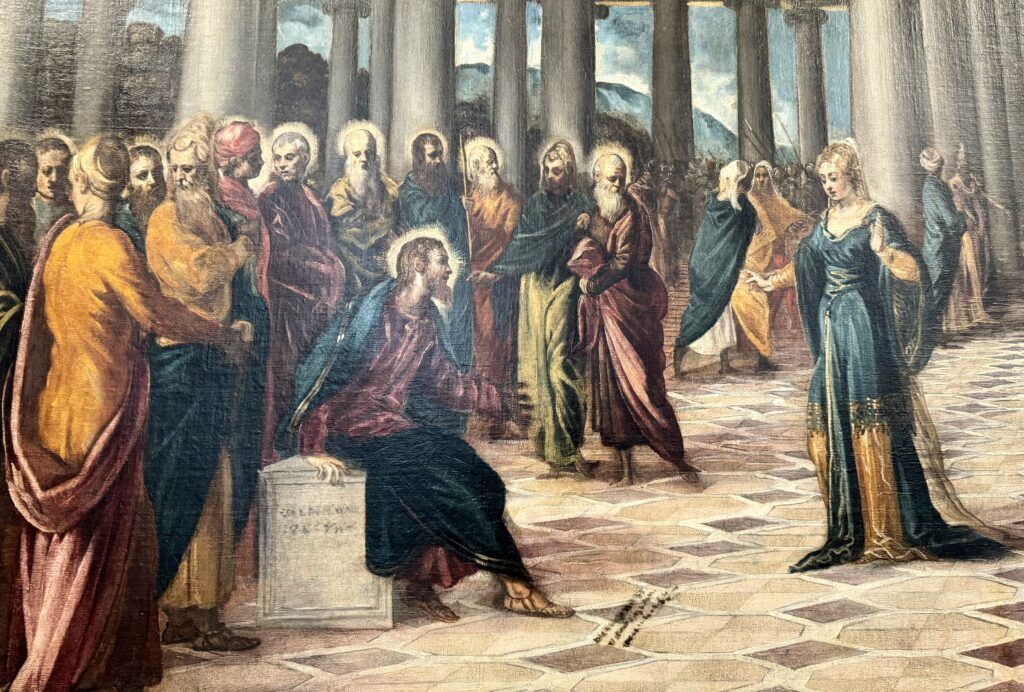
4. Tintoretto: Christ and the Woman Taken in Adultery
This painting is an important early work by Tintoretto. Tintoretto was a Venetian Renaissance painter known for complex compositions and religious narratives.
His work didn’t have the classicism or geometry typical of the Renaissance. Thus, Tintoretto is sometimes associated with the later Mannerists.
The painting is a meditation on the inherent hypocrisy in passing judgment on others. In it, an adulteress is condemned to death. But Christ, surrounded by his apostles, admonishes and silences the critics, who exit stage right.
The skilled use of perspective and light are characteristic of Tintoretto paintings. Unlike other painters of the era, you can see that Tintoretto used more hasty gestural brushwork, a trademark that would influence later generations.
5. Bernini, Portrait of Urban VIII
The legendary Bernini animated all of Rome with his beautiful sculpture and architecture in the 17th century, especially St. Peter’s Basilica and Square.
He carved his first bust at just age 8. And all the things that made Bernini the “master of marble” can be found in his portrait busts.
In this bust of Pope Urban VIII, Bernini does his usual emotive work. It’s all in the details — the unshaven hair on his chin, the deeply incised irises, the detailed eyebrows, and the shape of his eyes.
Bernini gives the impression of life, as if the pope were standing before you.
6. Guido Reni, Beatrice Cenci
This sad and expressive portrait was allegedly painted by “The Divine Guido Reni.” Reni was an eccentric man. He was deeply religious, a virgin, a misogynist, and a gambling addict. Reni was known for his moving religious and mythological works.
According to legend, Cenci murdered her father after he repeatedly raped and abused her. A public and controversial trial ensured.
After being convicted, Cenci was publicly beheaded outside the Castle Sant’Angelo by papal authorities. Later, she was mythologized as a martyr.
The painting captures Beatrice on the eve of her execution. Wrapped in white, she’s the image of virtue and purity.
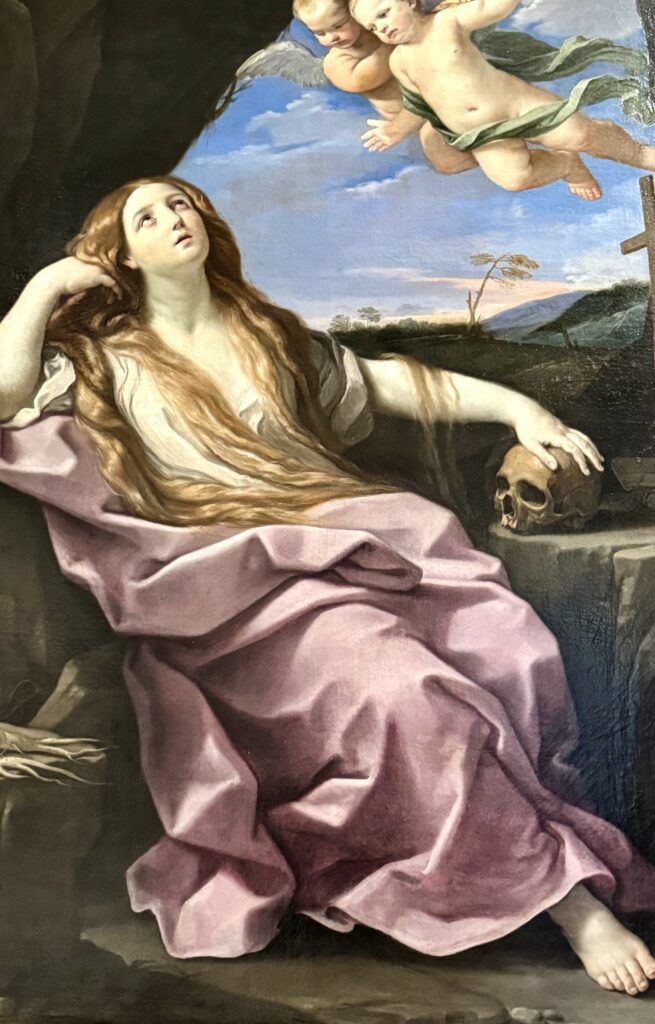
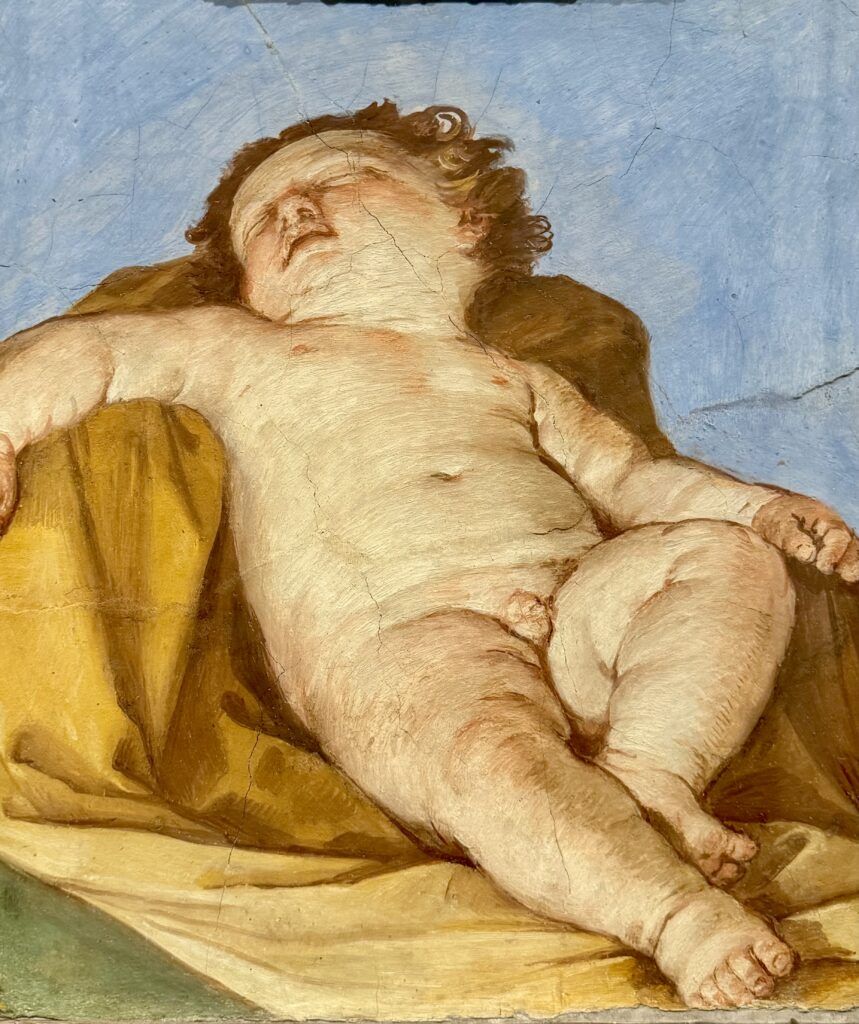
The painting awed and inspired many artists (Hawthorne, Melville, Dickens Stendhal, and Shelley), who documented their journey to Rome to see it on their grand tours. It appeared in two of Edith Wharton’s novels.
The provenance of the painting, however, has been questioned. Many believe it’s the portrait of an unidentified sybil (prophetess in ancient Greece), not Beatrice Cenci.
Some believe it wasn’t even painted by Reni, but by his workshop. But the Barberini label has not changed, allowing the romantic and centuries old story to stay intact.
7. Hans Holbein the Younger, Portrait of Henry VIII
The most iconic depiction of England’s most notorious monarch isn’t in London, as you’d expect. Nope, it’s in the Palazzo Barberini in Rome.
Holbein portrays a fierce looking Henry VIII. It’s a visual you might expect for an arrogant man who defied the catholic church, launched his own religion, and thought nothing of beheading his wives.
Henry VIII was 49 when Holbein captured him in paint. The portrait was marked to celebrate the occasion of his marriage to Anne of Cleves. This was Henry’s shortest marriage, lasting only 6 months and quickly unannuled.
The painting is square and Henry VIII’s body is square. His face is frontal and absolutely static. The date is written across the painting, bringing attention to his squinty eyes.
The king is luxuriously robed in complex patterns. The arc of the circular necklace is a sort of halo, suggesting Henry VIII’s divinity.
The painting is so polished that you can’t see a single brushstroke.
8. Il Sodoma, The Three Fates
In ancient Greek mythology, people thought their lives were determined by three fates — Clotho (the Spinner), Lachesis (the Alloter), and Atropos (the Inflexible).
The fates were sister goddesses, viewed as severe and unmerciful. They assigned individual destinies to children at the moment of birth. And they were a popular subject for artists.
This version of the three fates is by Milanese painter Giovanni Antonio Bazzi, called Il Sodoma. He was a Milanese painter who bridged the High Renaissance and the Mannerist period of art.
He was dubbed Il Sodoma either because of his rumored homosexuality or, more likely, based on his home town.
In the painting, Sodoma gives us a classical depiction of the three fates. They each hold weaving tools, indicating that they “spun and cut the thread” of human fate.
9. Artemisia Gentileschi, Self Portrait
Though this painting is not very well preserved, I fell for Baroque painter Artemisia Gentileschi and her beautiful Self Portrait.
I had just listened to an Art Curious podcast about her famous painting Judith Beheading Holofernes, which is much gorier than Caravaggio’s and is housed in the Uffizi Gallery in Florence.
Artemisia survived a rape by her tutor. After a move to Florence, she flourished and was the first woman admitted to the Accademia.
Inexplicably, for that time, she had many royal patrons. They didn’t want their own self portraits. She was so famous that they wanted Artemisia self portraits.
Here’s my complete guide to the life of Artemisia Gentileschi, a proto-feminist, and her most important works.
10. Filippo Lippi, Annunciation
Filippo Lippi was one of the leading Renaissance painters in Florence and the tutor of the more famous artist Sandro Botticelli.
His paintings were some of the first to use a more naturalistic and expressive style. They showed the influence of Netherlands pioneers like Jan Van Dyke.
This beautiful painting depicts a standard annunciation scene, where an angel tells Mary she’ll soon be a mother. Lippi paints the moment in a richly decorated interior.
The arabesques and vegetable motives in gold are particularly beautiful. Mary is framed by architectural elements, which underscore her importance.
It’s thought that the painting may once have been placed on the altar in the palazzo chapel.
11. Antonio Corradini, Veiled Woman
This marble sculpture is incredible. It’s supposed to be the vestal virgin Tuccia.
In ancient Rome, the vestal virgins were tasked with keeping the fire burning in the Temple of Vesta in the Roman Forum. They also had to take vows of chastity. If they failed in either respect, the normal punishment was to be buried alive.
Tuccia was accused of violating her oath. But the charge was false.
Tuccia protests her innocence and begs the goddess Vesta for help. With Vesta’s divine intervention, Tuccia is able to gather water in a sieve, a seemingly impossible task, to exonerate herself.
Corradini’s sculpture is beautiful. The veiling over Tuccia’s face and body is filmy, finely detailed, and elaborate. It’s difficult to believe it’s really marble. The veil reflects the oath of chastity.
12. Hall of Pietro da Cortona
Room 30 was the main reception room of the Palazzo Barberini. The double height Grand Salon, is a showstopper.
It sports a completely over the top Baroque ceiling fresco. Pietro da Cortona received the official commission from Pope Urban VIII’s nephew, Francesco Barberini.
Cortona’s busy masterpiece is filled with clouds and swirling figures. Titled Triumph of the Divine Providence and the Barberini family, the fresco symbolizes the spiritual and secular glory of the Barberini family.
The ceiling is the apotheosis of the Baroque’s trompe l’oeil style of painting, called quadratura, and meant to “trick the eye.” The ceiling appears to open up to the heavens.
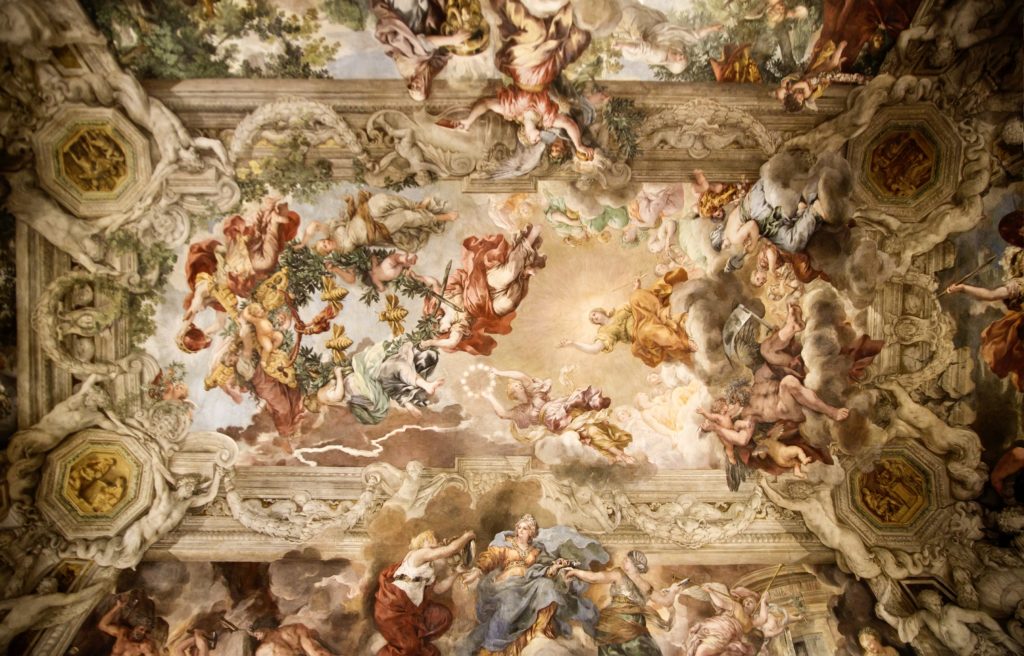
Dozens of figures cavort across the ceiling. As in the Sistine Chapel, the ceiling has a painted cornice or structure, which allowed Cortona to paint in sections.
Seated on solid clouds, Divine Providence watches over the action. (She’s reminiscent of Raphael’s sibyl in the Chigi Chapel in Rome.) She commands a personification of Rome to crown the Barberini coat of arms.
At the bottom, the goddess of wisdom casts out giants that interfere. Barberini bees swarm up to greet Divine Providence herself.
It may seem arrogant for a family to paint themselves into mythological scenes. But this type of conceit was fairly standard for prominent families at the time.
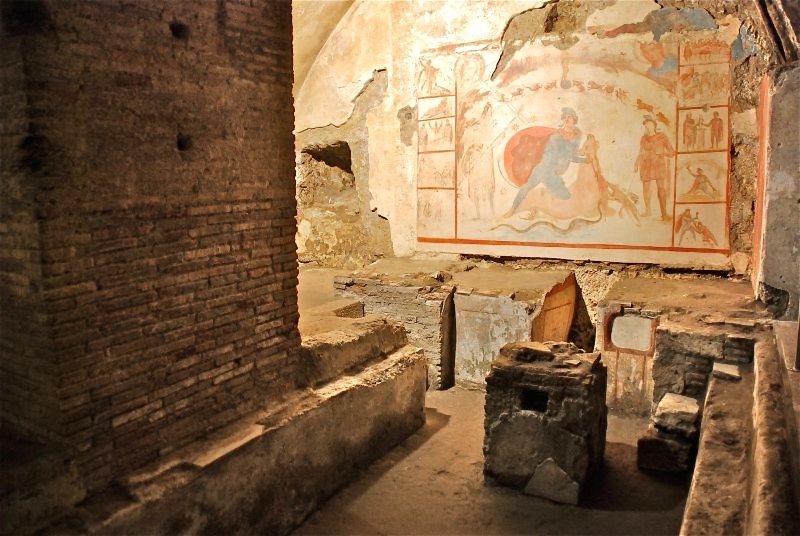
13. The Mithraeum Of Palazzo Barberini
The Barberini Mithraeum was discovered in 1936 in the garden of the Palazzo Barberini, owned by Conte A. Savorgnan di Brazza.
It’s a mysterious cavern dating to the third century AD. It was discovered by chance in 1936.
The rectangular chamber has a vaulted ceiling and a striking fresco depicting the god Mithras sacrificing the bull.
Very little is known about the all male Roman Cult of Mithras or its rituals. Historians think the mystery cult first appeared in the 1st century and spread throughout Europe. It declined when Constantine introduced Christianity.
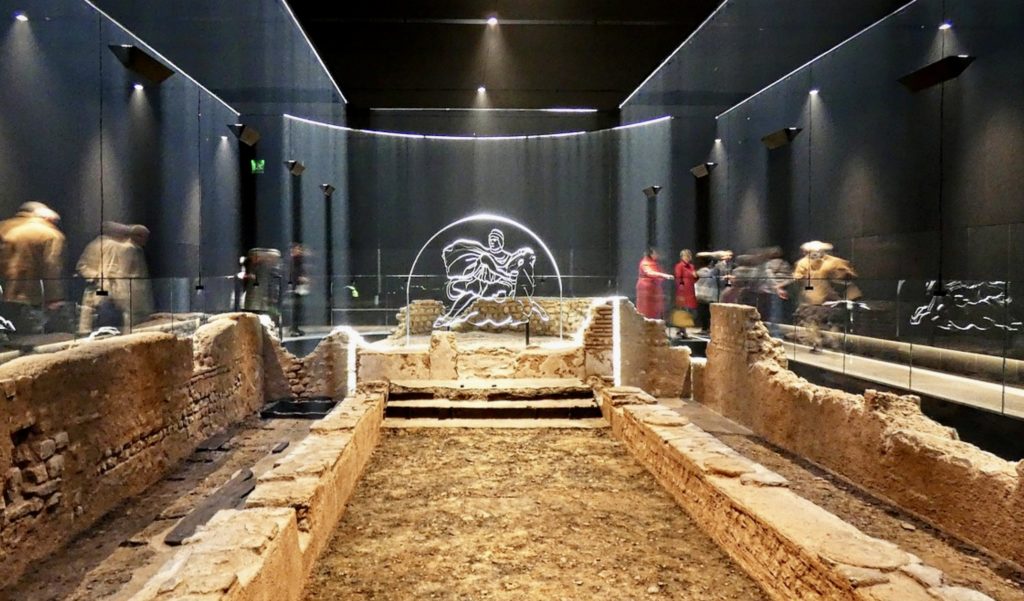
Members of the cult came from the Roman military and political elite. They were required to embody the strength and stamina of the god Mithras.
The temple may have been a place for feasting, drinking, and ritualistic male bonding.
What historians do know about the cult is that its central icon and hero figure is an image of Mithras. The Persian god is typically depicted in a Perisan-style cap.
The Mithraic ceremonies were probably held in a dark cave-like setting. Light was likely provided by candles or torches.
In the 4th century, Mithraists faced persecution from Christians. Mithraism was subsequently suppressed and eliminated in the Roman empire by the end of the century.
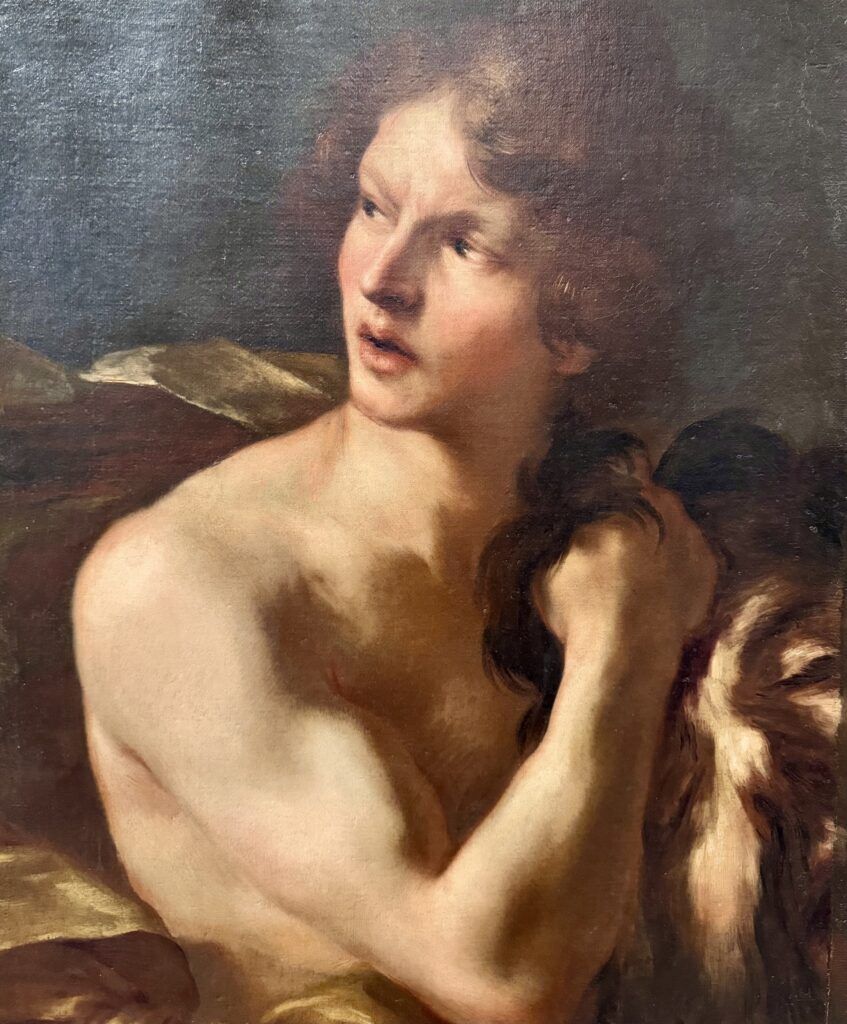
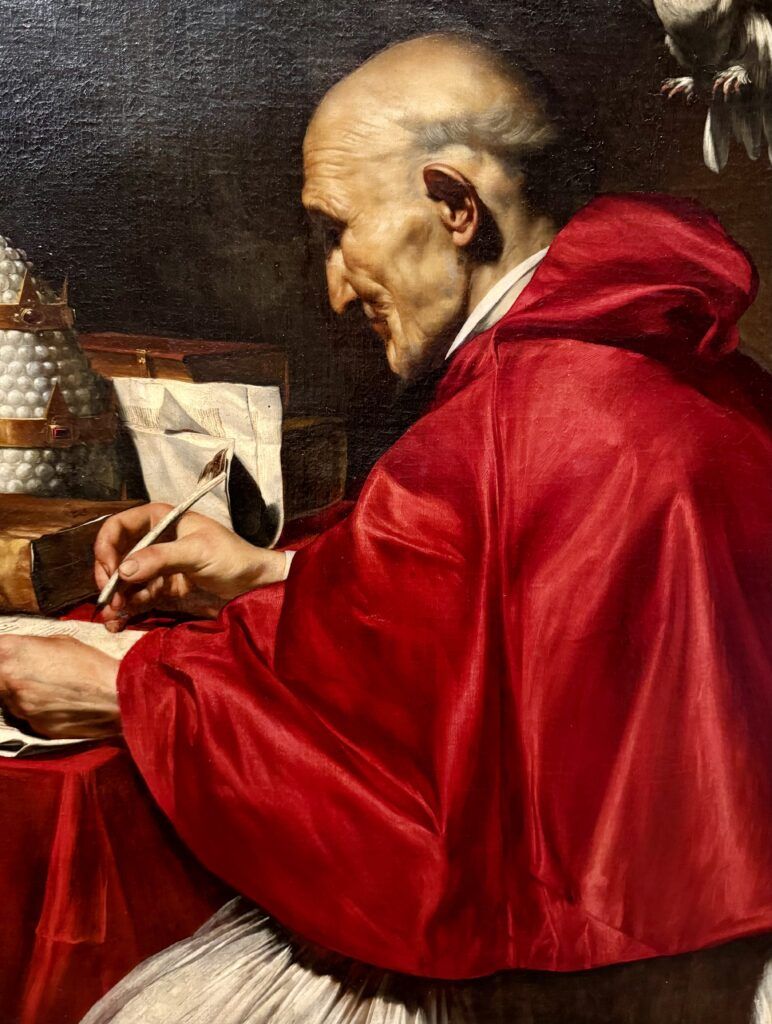
Practical Guide & Tips For Palazzo Barberini
Address: Via delle Quattro Fontane 13
Hours: Tuesday to Sunday 8:30 am to 7:00 pm, closed Mondays.
Entry fee: € 13
You can purchase a ticket online here. You can also book a skip the line ticket on Get Your Guide.
The underground Mithraeum is only open by guided tour on the 2nd and 4th Saturday of the month. You can book a ticket for that here.
Guided Tours: You can also book a 2 hour guided tour of the museum.
Metro: Barberini
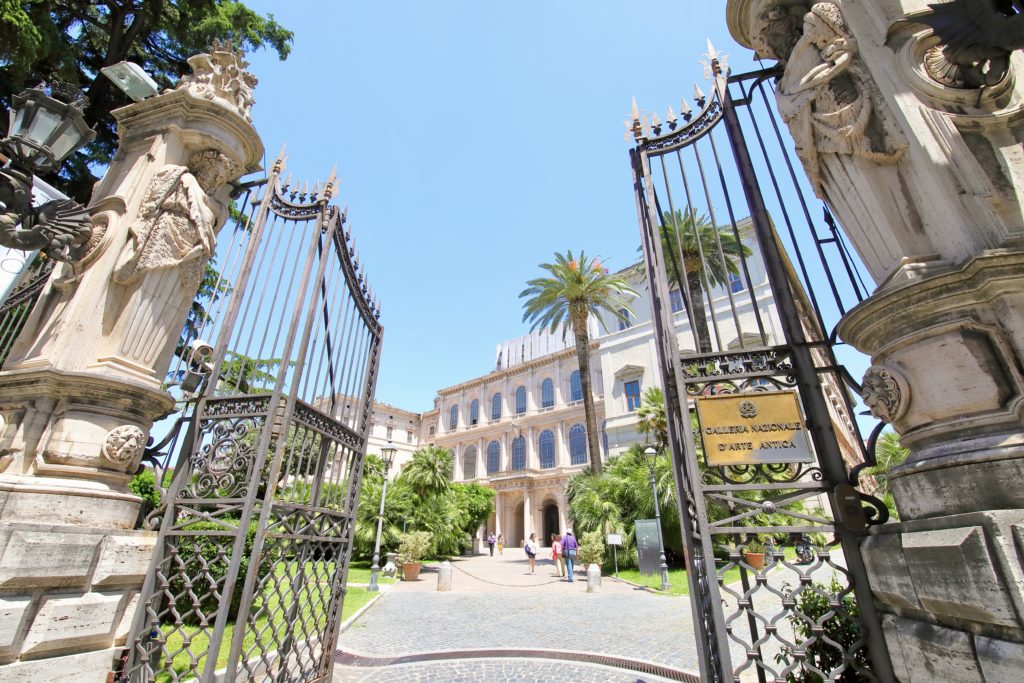
Pro Tips:
Your ticket to the Palazzo Barberini also gives you free entrance within 10 days to the Galleria Corsini in the Trastevere neighborhood.
Everything is well labeled in English and Italian. You don’t really need an audio guide.
The garden is the back is lovely and has been restored. You can visit the garden for free.
You may enjoy these other Rome travel guides and resources:
- 8 ways to spend 1 day in Rome
- 3 day itinerary for Rome
- 5 day itinerary for Rome
- Hidden gems in Rome
- Best museums in Rome
- Archaeological sites in Rome
- Guide to the Borghese Gallery
- Guide to Palatine Hill
- Guide to the Roman Forum
- Guide to the Colosseum
- Walking tour of central Rome
Pin it for later.
